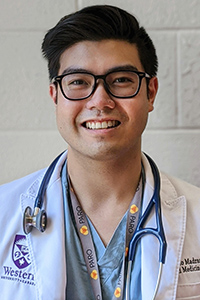Resident Spotlight: Dr. Lorenzo Madrazo, Internal Medicine
 Before going into medicine, Dr. Lorenzo Madrazo trained to be a music teacher. From patient education to working with junior learners, he enjoys the aspects of teaching he continues to encounter as a second-year resident in Internal Medicine.
Before going into medicine, Dr. Lorenzo Madrazo trained to be a music teacher. From patient education to working with junior learners, he enjoys the aspects of teaching he continues to encounter as a second-year resident in Internal Medicine.
He is also focused on medical education research with the Centre for Education Research and Innovation, looking at how medical trainees adopt a physician identity.
What has been the most rewarding aspect of residency?
Before I went into medicine, I trained to be a music teacher. Because of that, teaching continues to be one of my favourite aspects of residency. One of the highlights of talking to patients is educating them and their families about their health, allowing us to engage in shared decision-making. I also always enjoy mentoring and working with junior learners – especially in a team setting where we can learn from one another.
Why did you choose the School’s Internal Medicine program?
I admired the warm collegiality and excellent teaching among the residents, staff and physicians at Schulich Medicine & Dentistry. With my interest in general medicine, I liked the balance and diversity of the program and the subspecialty rotations made available to residents. The size of the centre is ideal for seeing a good variety of internal medicine cases while also small enough to get to know the hospital community well.
What is the program’s biggest strength?
Our program’s biggest strength is its people. My co-residents are the best group of colleagues anyone can ask for. Even when work gets busy, especially overnight, it’s always a silver lining to know that I’m on call with other Internal Medicine residents.
Our program administrators ensure that we are getting the most out of our training and work closely with us to organize different rotations of interest, as well as vacation time for important life events. With the onset of the pandemic, our program has been very responsive to feedback from residents as various hospital policies changed aspects of our training.
What types of cases and patient populations do you work with?
We see a diverse group of adult patients in Internal Medicine and each subspecialty certainly has its specific patient populations. We generally care for older patients who have multiple comorbidities affecting their health. How these different conditions and the treatments interact with one another is what makes internal medicine interesting and challenging. Many of our patients also face challenging social circumstances intertwined with their medical issues. The care we provide tries to take patients’ social circumstances into account to ensure that they are well supported to navigate their illness.
What learning opportunities have you pursued as a resident beyond the clinical environment?
Outside my clinical work, I’ve been fortunate to work on qualitative research in medical education relating to professional identity formation – the process through which medical trainees adopt a physician identity. I value the mentorship and support from supervisors and research staff at the Centre for Education Research and Innovation at the School.
I’ve also had the opportunity to serve as a liaison representative for the Resident Doctors of Canada and advocate for residents across the country.
What do you enjoy most about living in London?
I enjoy discovering all the ‘hidden gems’ within London, including local restaurants and hiking trails. Getting around the city is easy and makes commuting to work ideal. London is also a short drive away from places like Stratford and Port Stanley, which are also worth a visit.








